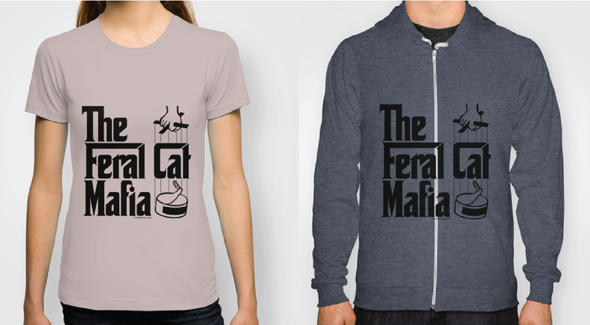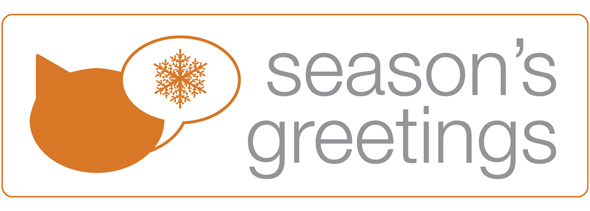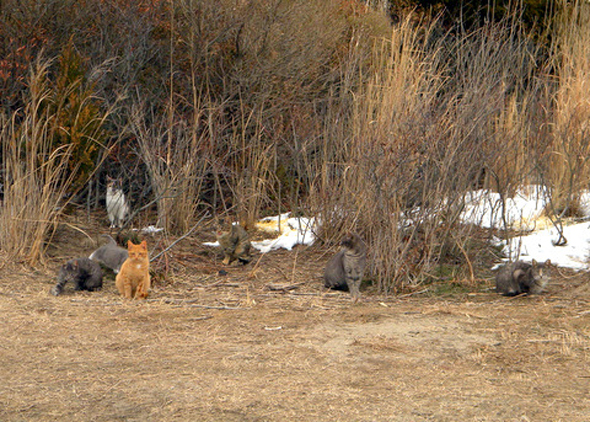Among the many news stories, research studies, and government reports brought to my attention last week was an article in Monday’s Toronto Star (thanks, once again, to the good folks at Alley Cat Rescue, who routinely put Google Alerts to shame!). What I find compelling about the article is not its central story (another community struggles with their “feral cat problem”), but the way it illustrates so much of what’s wrong with the free-roaming/feral cat/TNR debate.
In a nutshell, the story is about the town of Oakville changing its bylaws so that cats are no longer allowed to roam free. Wrong-headed policy, in my opinion—but more problematic is the case being made for this policy: what’s being said, how it’s being said, and by whom.
Déjà Vu
One doesn’t have to read further than the first line—“Sylvester and Tweety almost got it right”—to know that this is one of those stories. The kind of story that uses corny references to downplay the implications of a large-scale witch hunt. The kind of story that, frankly, makes it tough to feel much sympathy for a newspaper industry struggling for survival.
“In their cartoon world, the brainy yellow bird always outsmarts the puddy tat. In the real world, the cat kills the canary—and as many as one million birds daily in North America. This is causing a growing, sometimes violent, rift between animal lovers.”
Where that one-million-birds-per-day rate comes from is anybody’s guess, though it sounds awfully familiar—more than likely, one of American Bird Conservancy’s talking points. As for the “violent rift” reporters Mary Ormsby and Jim Wilkes refer to, that comes later.
“The crucial question: Should cats, which are natural hunters, be allowed to freely to roam the streets?”
It’s a fair question, but it’s not as if cats are the only natural hunters found in urban areas. In Chicago, for example, more than 60 coyotes are “roaming parks, alleys, yards and thoroughfares.” (The NPR story claims that coyotes kill area dogs and cats only “every so often,” but in light of Judith Webster’s 2007 paper “Missing Cats, Stray Coyotes: One Citizen’s Perspective,” I’m quite skeptical of such assertions.)
And then, of course, there are the raptors—birds of prey (which are attracted by, among other things, bird feeders—but I’ll get to that shortly).
All Sticks, No Carrots
Progressive animal service organizations have figured out that charging people to house their stray animals (i.e., the “traditional” approach) only hurts the animals and the community at large. Like mandatory spay-neuter laws, it’s great on paper but disastrous in practice.
Yet, this is precisely the direction (read: backwards) Oakville is taking.
“Owners whose loose cats repeatedly end up at the Oakville shelter can be fined $105, plus a $30 town surcharge, a return fee of $25 and $15 for each day the cat stays at the shelter.”
Such a policy virtually guarantees a dramatic increase in intakes—and killing.
“Johanne Golder, executive director of the Oakville and Milton Humane Society, which is contracted by Oakville to provide animal control services… said the mentality that cats are “disposable” pets (unwanted kittens are often abandoned or dumped at shelters) is to blame for the huge feline populations in urban centres.”
Again, a fair point—but I fail to see how the proposed “solution” will improve the situation. And it’s very likely to be a death sentence for the area’s feral cats.
Witch Hunt
Readers who might have similar misgivings are (presumably) set straight when Ormsby and Wilkes explain the threats posed by free-roaming cats:
“The more cats, the fewer birds, said McGill University avian expert David Bird. He said house pets are just as bloodthirsty as untamed ferals—homeless offspring of stray or abandoned cats raised without human contact. Bird (his surname and passion are coincidental, he chirped) estimated well-fed pets alone destroy upwards of a billion birds annually around the world. The American Bird Conservancy (ABC) estimates hundreds of millions are killed in the United States by cats each year but says an exact figure is unclear.”
“Unclear” is right! Anybody even vaguely familiar with the subject would agree that “an exact figure is unclear.” But for Bird to suggest that it’s even possible—or meaningful—is ridiculous. And highly irresponsible. Are we talking about islands or continents? Which part of the world? Rare or common species? Healthy or unhealthy birds? Etc.
And what’s the impact of this predation?
This is ABC’s kind of science: one that strives not for an increased degree of certainty, but greater ambiguity—while at the same time painting a decidedly grim picture. There’s a name for this, of course: propaganda.
Which is precisely what Bird advocates for in “What Conservation Biologists Can Do to Counter Trap-Neuter-Return: Response to Longcore et al.” Along with his nine co-authors, Bird calls on conservation biologists to “begin speaking out” against TNR “at local meetings, through the news media, and at outreach events.” [1]
(Late last year, co-author Peter Marra earned his Propaganda Badge via a Washington Post article, though the research findings he cited there have since been removed from the Smithsonian Migratory Bird Center’s website.)
Rhetoric
Just as important as Bird’s absurd claim, though, is the language used. Indeed, it was the word bloodthirsty that rankled Alley Cat Rescue founder Louise Holton. And there’s plenty more where that came from:
“Bird, the author of The Bird Almanac and Birds of Canada, said the cat-on-bird carnage is as common in quiet residential cul-de-sacs as it is in the countryside.
I’d created a killing field in my own backyard,” recalled the wildlife biology professor, who once spotted four neighbourhood cats stalking finches, woodpeckers, nuthatches, juncos, jays and cardinals nibbling at feeders around his west Montreal home.”
Really, a killing field? Somehow, I don’t think any birds were killed at all. Had any harm come to his birds, I have no doubt Bird would have let readers know in no uncertain terms. This sounds like a Winterism: the careful arrangement of true statements for the purpose of creating a false impression.
Then, too, stalking is not catching or killing, as Fitzgerald and Turner point out:
“Hunting for birds requires stalking, since many species of birds have an up to 360˚ field of view and can detect a cat approaching them from behind [2]… The ‘wait’ just before the pounce is a characteristic element of the cat’s hunting behaviour and many birds also fly away during this ‘wait’ without ever having noticed the cat. Because of these failures, many cats soon give up bird hunting altogether.” [3]
Us and Them
When Bird complains, “I didn’t think it was right for other people’s hobby interest, i.e., owning a pet cat, to impinge upon my interests on my own property,” he betrays his profoundly myopic world view as much as any property rights concern he might have. Cat ownership a hobby interest? Tell that to the 38.2 million U.S. households owning, collectively, something like 94 million cats (my apologies—I don’t have statistics for Canada), which are, increasingly, treated like members of the family.
Is it any wonder “bird people” and “cat people” (classifications I use with some hesitation) have such difficulties communicating?
Bird seems to imply that his bird feeders are inherently benign—but again, that’s from his point of view. “Feeding birds is,” according to the Cornell Lab of Ornithology’s website, “a wonderful way to get to know your birds better! But, bird feeders can also be deadly.”
“Predators (cats, hawks, even dogs) can easily find birds at feeders, dirty feeders can spread disease, feeders can attract non-native, invasive species (house sparrows, brown-headed cow birds, and starlings for instance) which can be detrimental to native birds, and birds might fly away quickly and crash into nearby windows.”
How different is this from the “rationale” typically used to ban the feeding of feral cats? If feeding feral cats is in imposition on the community at large, then so are bird feeders. Should communities require people feeding birds to apply for permits, just as city officials in Yuma, AZ, want to require permits for those conducting TNR?
The way Ormsby and Wilkes tell it, though, birders are up against some kind of powerful cat lobby:
“Bird advocates like him are up against a multi-million-dollar cat-care industry in an animal rights fight that has been tested in U.S. courts, written about in a best-selling novel and spawned an outdoor furniture business to erect enclosed “catios” to give kitty a breath of fresh air.”
Had the reporters followed the money, they would have found a very different story on the advocacy front. According to the most recent data available from Charity Navigator, Alley Cat Allies’ net assets (as of July 2009) were about $2.8 million, compared to $3.7 million for ABC (December 2009). And the National Audubon Society holds in excess of $255 million (June 2009).
All of the sudden, that “multi-million-dollar” characterization doesn’t mean so much.
Cat Crazed
To further their case, Ormsby and Wilkes turn to Maureen Palmer, director of the recently released documentary Cat Crazed (currently unavailable for online streaming outside of Canada, though an audio interview with Palmer is available via the CBC).
“Palmer said one of the most ‘heartbreaking’ scenes during filming was at a volunteer spay-neuter clinic in Los Angeles that sterilized 80 ferals a day. She said most of the cats had infections that never healed, as well as broken bones, large abscesses around their teeth and mange.”
That does sound heartbreaking. But is it true?
I contacted Kim Senn, VP of Operations at FixNation, the clinic Palmer visited for the film. “We are fixing between 70–80 cats a day at FixNation,” she told me via e-mail, “and the overwhelming majority of them are healthy.”
“Less than 5 percent have any medical issues that prevent us from sterilizing them. The common, non-life-threatening issues we do see—like fleas, mange or an occasional abscess—are easily treatable while the cat is here at our clinic, and the cat is left better off than before TNR. And no longer reproducing, which is the best part.”
Immigration Status
Ormsby and Wilkes also touch on one of the most threadbare complaints against free-roaming and feral cats: their “status” as non-native. (Stay tuned for a follow-up story detailing (1) the exact date and time when North America was “pristine,” and (2) precisely how we might return to that mythical Eden.)
“Cats actually never roamed freely in North America until they were introduced by humans. The animals—rodent hunters in the wild—were first domesticated 7,000 years ago in the Middle East and Africa, according to researchers at the University of Nebraska. Those ancient cats evolved into a separate species called the domestic or house cat.”
Of all the possible sources the Toronto Star could consult about the history of the domestic cat, they turned to the authors of “Feral Cats and Their Management”? Isn’t that a bit like consulting Michael Vick about the history of the American Pit Bull Terrier?
“Since cats are not native predators in this part of the world, nesting North American birds have no natural defences against the agile tree climbers. Birds are already under stresses from habitat destruction, pollution, climate change and other animals, such as squirrels, who eat unattended eggs.”
Here, it seems, Ormsby and Wilkes have gone off the deep end, taking an argument used to explain the significant impact cats can have on island populations of birds and other animals—literally—to another level. As Fitzgerald and Turner write:
“Any bird populations on the continents that could not withstand these levels of predation from cats and other predators would have disappeared long ago, but populations of birds on oceanic islands have evolved in circumstances in which predation from mammalian predators was negligible and they, and other island vertebrates, are therefore particularly vulnerable to predation when cats have been introduced.” [3]
At the risk of stating the obvious: birds can fly—at least the ones found in trees can. That’s quite a defense against cats—less so against raptors, of course. Or buildings, pesticides, power lines, wind farms, etc.
Life Imitates Art
Ormsby and Wilkes quote Jonathan Franzen, whose latest novel, Freedom, touches rather directly on, as they put it, “the tension between cat people and bird people.”
“There are many ways for a house cat to die outdoors, including dismemberment by coyote and flattening by a car but when the Hoffbauer family’s beloved pet Bobby failed to come home one early-June evening, and no amount of calling Bobby’s name or searching the perimeter of Canterbridge Estates or walking up and down the county road or stapling Bobby’s Xeroxed image to local trees turned up any trace of him, it was widely assumed on Canterbridge Court that Bobby had been killed by Walter Berglund.”
Actually, Franzen is more of an insider than the reporters let on; Franzen, winner of the 2001 National Book Award and a Pulitzer Prize finalist the following year, sits on ABC’s board of directors, and he wrote the foreword to their recently released book, The American Bird Conservancy Guide to Bird Conservation (brilliant move: ABC has been publishing fiction for years now; at last, they have somebody on board who does it well). Franzen is also a fervent believer.
Ormsby and Wilkes end their article with a brief summary of a 2007 animal cruelty case that made headlines across the U.S. and beyond.
“In Texas five years ago, Jim Stevenson killed a cat. The Galveston ornithologist fatally shot a feral with a .22-calibre rifle, claiming the creature was killing piping plovers, an endangered shorebird species. Stevenson was charged with animal cruelty but walked free in 2007 when jurors failed to come to a decision and a mistrial was declared.”
Rather a dry telling of it, if you ask me. After hearing of bloodthirsty cats, backyard killing fields, and all the rest, aren’t readers entitled to a little more drama? Here, after all, is the only evidence of that “violent rift” Ormsby and Wilkes referred to early on—though, of course, it’s far more one-sided than the reporters suggested with their ominous foreshadowing.
That “feral,” by the way, was part of a colony cared for by John Newland, who, according to Assistant District Attorney Paige Santell, “had fed them, watered them, provided shelter for them, provided toys for them, provided vet care for some of them.”
“This animal suffered a great deal,” says Santell, during an interview with Alley Cat Allies. “That was another part of this case. I mean, this animal did not die right away. It took, you know, 30 to 45 minutes before it died. It was in a terrible amount of pain.”
It must be that Ormsby and Wilkes had hit their word limit already—it’s not as if they don’t like a good story.
The High Cost of a Free Press
Whether Ormsby and Wilkes were unable or unwilling to do this story justice I can’t say, but, as a piece of journalism, their finished product is astonishingly bad.
Not that they’re alone. On the contrary, they have plenty of company.
Last year around this time, when the Los Angeles Times ran a story about the injunction against city-funded TNR, reporter Kimi Yoshino invoked Sylvester and Tweety. And swallowed in one gulp the ridiculous claim by ABC’s Steve Holmer that “there are about . . . 160 million feral cats [nationwide].”
In December, several newspapers treated “Feral Cats and Their Management” as if it were legitimate research. Among the worst were Dale Bowman’s column in the Chicago Sun-Times (December 6), Scott Shalaway’s column (December 12) in the Pittsburgh Post-Gazette, and an editorial (unsigned for good reason) in Lincoln’s Journal-Star (December 7).
And, it just keeps on coming.
Even as I was working on this post, somebody alerted me, via the Vox Felina Facebook page, to an opinion piece in the London Free Press (in which “expert” Theo Hofmann comes up short on both facts and logic: “Cats don’t eat the birds, they just kill them… So they really are causing a great deal of damage…”).
Do news accounts of cats killing a million birds a day turn ordinary citizens into Jim Stevensons? Or reports of 160 million feral cats (one for every two humans in this country!) provoke the kinds of horrors chronicled on the Cat Defender blog? Of course not.
On the other hand, the cumulative effect of such news coverage surely contributes to a misinformed public/electorate. Which, in turn, paves the way for misguided policy. (See, for example, Utah’s House Bill 210, sponsored by Republican Curtis Oda, which proposed to relax “provisions of the Utah Criminal Code relating to animal cruelty and animal torture,” in order to allow, among other things, “the humane shooting or killing of an animal if the person doing the shooting or killing has a reasonable belief that the animal is a feral animal.”)
Journalists have an obligation to approach any story with some healthy skepticism. They owe it to their readers to set aside, as much as possible, their own biases—and challenge those of their sources. To bring to the table some critical thinking and professional integrity.
When it comes to the subject of free-roaming/feral cats/TNR, however, the public rarely gets anything more substantive than a one-sided collection of talking points, sprinkled with cartoon references.
Literature Cited
1. Lepczyk, C.A., et al., “What Conservation Biologists Can Do to Counter Trap-Neuter-Return: Response to Longcore et al.” Conservation Biology. 2010. 24(2): p. 627–629. www.abcbirds.org/abcprograms/policy/cats/pdf/Lepczyk-2010-Conservation%20Biology.pdf
2. Tabor, R., The Wild Life of the Domestic Cat. 1983, London: Arrow Books.
3. Fitzgerald, B.M. and Turner, D.C., Hunting Behaviour of domestic cats and their impact on prey populations, in The Domestic Cat: The biology of its behaviour, D.C. Turner and P.P.G. Bateson, Editors. 2000, Cambridge University Press: Cambridge, U.K.; New York. p. 151–175.





